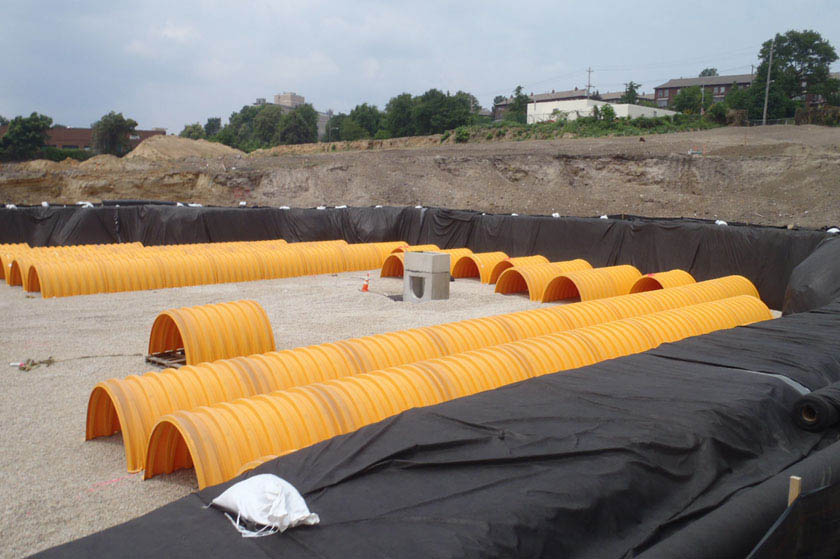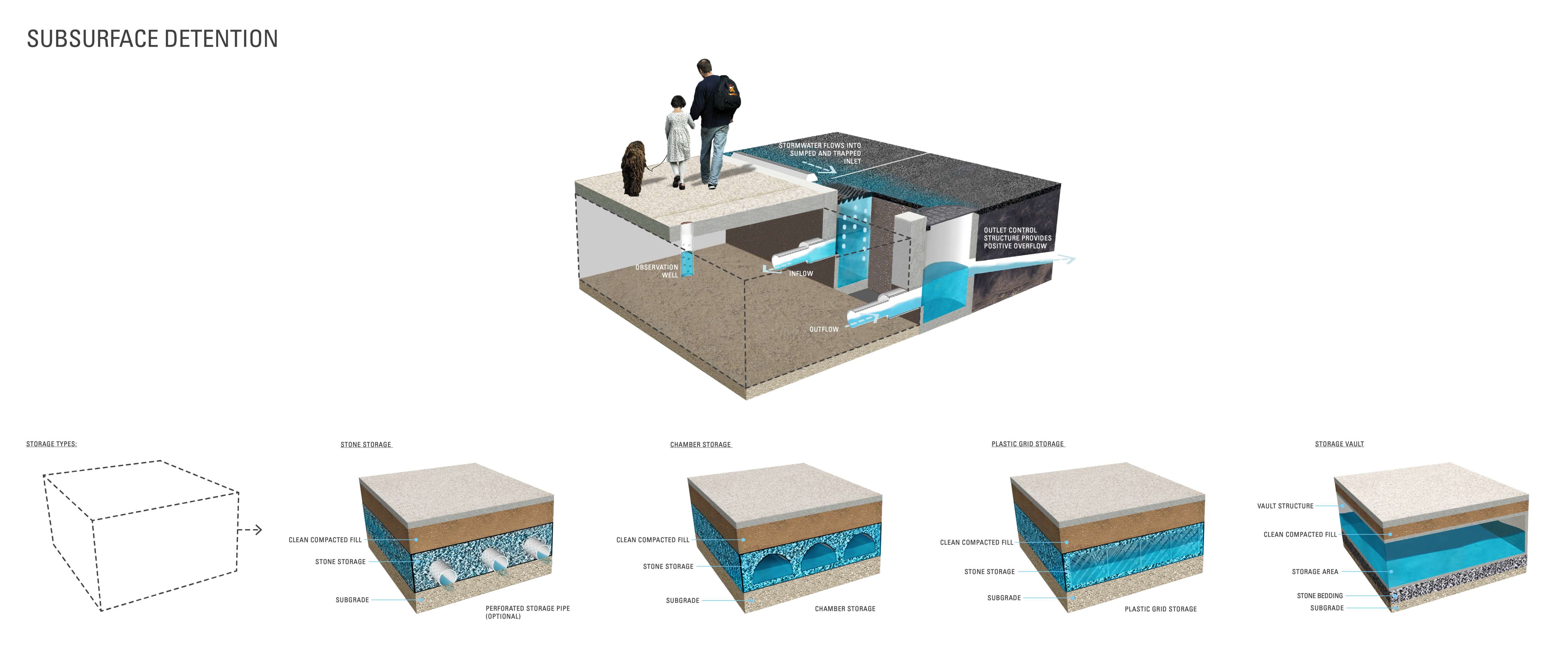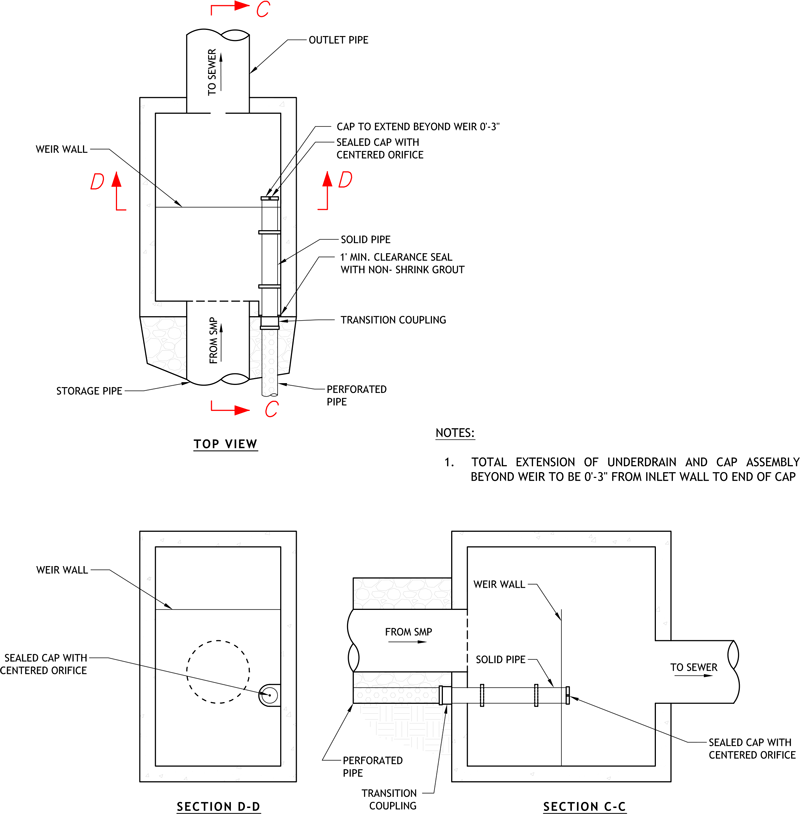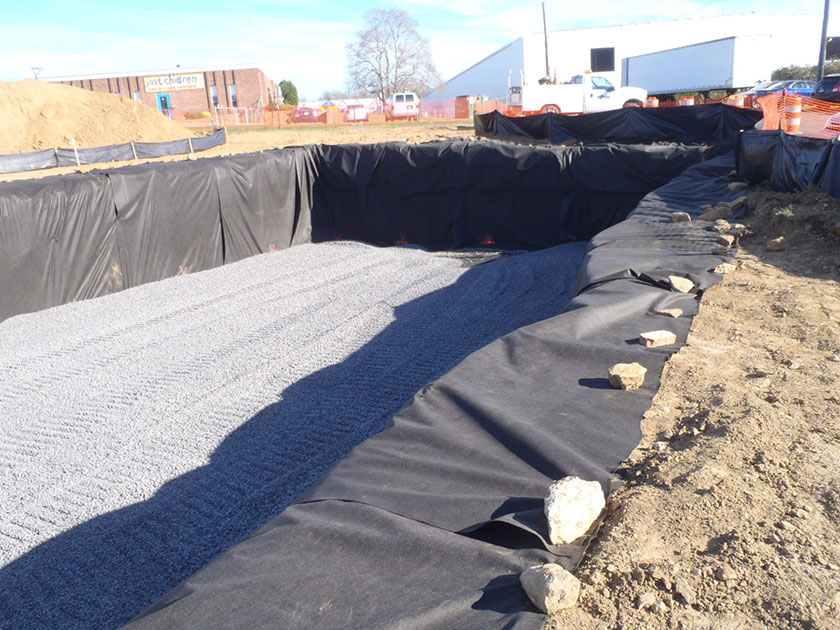Download summaries of this SMP and its maintenance guidance, with quick reference information for clients and developers:
Subsurface Detention SMP One-Sheet
Subsurface Detention Maintenance Guidance One-Sheet
4.8.1 Subsurface Detention Introduction
Subsurface detention stormwater management practices (SMPs) are underground structures that are used to temporarily detain and release stormwater. They can include vaults, stone storage, pipe storage, and plastic grid storage.
Quick Tip
Required subsurface detention design and material standards are denoted in this Section by easy-to-reference numerals.
Subsurface detention SMPs can be combined with other SMPs in series to meet the Philadelphia Water Department (PWD) Stormwater Regulations (Stormwater Regulations). The designer is referred to Section 3.2.3 for information on using SMPs in series.
Design of subsurface detention SMPs is not limited to the examples shown within this text. Successful stormwater management plans will combine appropriate materials and designs specific to each site.

When Can Subsurface Detention Be Used?
Subsurface detention SMPs are suitable on sites where infiltration has been deemed infeasible and space constraints prevent the use of surface-level or rooftop SMPs. Provided that overburden loads and utility conflicts are evaluated, subsurface detention SMPs can be sited beneath lawns, recreational areas, parking lots, and other hardscape surfaces.
Key Advantages of Subsurface Detention
- Manages stormwater runoff without occupying surface or rooftop space
- Can be sited, through flexible design options, beneath lawns, recreational areas, parking lots, buildings, or other impervious areas when space constraints exist
- Allows for easily adaptable footprints that can fit into almost any size space and be integrated into many different site layouts
Key Limitations of Subsurface Detention
- May need to be combined with other SMPs to meet the Water Quality requirement
- Can be more costly and difficult to install and maintain than surface practices like bioretention SMPs
- Require strict adherence to regularly scheduled inspections because the maintenance needs are not easily visible
- Require additional maintenance costs due to access limitations and Occupational Safety and Health Administration (OSHA) requirements
- Does not improve aesthetics or provide the ancillary environmental benefits associated with vegetated SMPs, such as habitat creation and improved air quality
Key Design Considerations for Subsurface Detention
- Appropriate pretreatment of runoff should be provided to remove sediment and debris before discharging to a subsurface detention SMP. A pretreatment approach should be developed based on the SMP’s expected level of sediment loading and anticipated difficulty of sediment removal.
- Before using subsurface detention to comply with Water Quality release rate requirements, it must be adequately demonstrated that infiltration is not feasible on-site. The designer is referred to Section 3.3 for information on infiltration testing requirements.
- Subsurface chambers, crates, or arches can be used to increase void space and reduce SMP footprint; however, long-term maintenance should also be carefully considered when evaluating such systems. Subsurface vaults can be periodically cleaned using vacuum cleaning, whereas it is much more difficult to remove accumulated sediment from stone storage and grid storage systems.
- The SMP and maintenance access should be located in an area where maintenance and potential repairs can be conducted with minimal disturbance to surrounding uses.
- Areas of soil contamination or unstable soils should be avoided; however, in some cases, an impervious liner may be appropriate.
- For any subsurface detention SMP that discharges onto an adjacent property, a drainage easement may be required and is recommended.
Subsurface Detention Types
Subsurface detention SMPs can be designed in a variety of different ways, but commonly fit into the following four categories:
Underground storage vaults are buried concrete, fiberglass, or polyethylene chambers that temporarily store and release stormwater. The designer is referred to Section 4.5, Cisterns, for more information on the use of underground storage SMPs for rainwater harvesting.
Underground stone storage consists of buried stone beds wrapped in geotextile that temporarily store and release stormwater. Stone storage beds provide the least amount of storage volume per unit area among the subsurface detention types. Removing sediment from underground stone storage is difficult, which necessitates effective pretreatment.
Underground pipe and chamber storage consists of perforated plastic or metal pipes, or pipe-like linear chambers, that are placed in a stone bed to provide more storage per unit volume and temporarily store and release stormwater. Various pipe dimensions and shapes can be used to optimize the storage volume to meet the specific site requirements.
Underground plastic grid storage consists of buried plastic structures that can be stacked and inter-connected to form various shapes and sizes. Grid systems can provide as much as 95% void space for storage of stormwater.
4.8.2 Subsurface Detention Components
Figure 4.8‑1: Subsurface Detention with Typical Features

Pretreatment Component
Pretreatment systems capture trash, sediment, and/or other pollutants from stormwater runoff before delivery to the storage area. Pretreatment needs will vary significantly depending on the contributing drainage area composition and use. Pretreatment can include structures such as sumped and trapped inlets, sediment/grit chambers or separators, media filters, inlet inserts, or other appropriate prefabricated or proprietary designs to remove sediment, floatables, and/or hydrocarbons from stormwater runoff prior to being conveyed to a subsurface detention SMP.
Pretreatment can also consist of filter strips, forebays, and swales. The designer is referred to Section 4.10, Pretreatment, for more information on pretreatment systems.
Inlet Control Component
Inlet control systems convey and control the flow of stormwater from the contributing catchment area to a subsurface detention SMP. Inlet control needs will vary depending on the design of stormwater conveyance systems and the site layout. The designer is referred to Section 3.4.2 for guidance on stormwater conveyance system design.
Inlet controls may include flow splitters, curbless design/curb openings, energy dissipaters, and inlets. The designer is referred to Section 4.11, Inlet Controls, for more information on inlet controls.
Storage Area Component
The storage component of a subsurface detention SMP is typically constructed of a stone-filled bed or trench, which may or may not incorporate pipes, arches, concrete vaults, crates, plastic grids, or other proprietary structures. The void spaces between the stones and/or structures store stormwater until it can be released downstream at a controlled rate.
A permanent pool of water may be incorporated to dissipate energy and improve the settling of particulate pollutants, in which case, the design may be referred to as a “wet underground detention SMP.”
Outlet Control Component
Outlet controls within a subsurface detention SMP can provide a range of functions, including the following:
- Meeting drain down time requirements;
- Controlling the rate of discharge from the SMP and limiting water surface elevations during various storm events; and
- Bypassing of flows from large storm events.
Outlet controls may include orifices, weirs, level spreaders, or low flow devices.
When coupled with the implementation of an acceptable pollutant-reducing practice, a subsurface detention SMP can be used to achieve a slow release rate in order to fully comply with the Water Quality requirement on sites that cannot infiltrate in the combined sewer area. This ability to slowly release the discharge into PWD sewers or receiving waters can also be used to meet Channel Protection, Flood Control, and Public Health and Safety Release Rate requirements, if applicable.
Typically, release rates for slow release systems are met using small orifices or other rate control devices. Additionally, the outlet control structure may require design and maintenance measures to avoid clogging. To accommodate these design mandates, PWD offers a design option in the form of an Underdrain Orifice Standard Detail (Figure 4.8‑2), which is also available to the designer as a downloadable CAD file.
Figure 4.8‑2: Underdrain Orifice Standard Detail

The designer is referred to Section 4.12, Outlet Controls, for more information on outlet controls.
Inspection and Maintenance Access Component
Safe and easy inspection and maintenance access to all major components within a subsurface detention SMP is critical to ensuring long-term performance. Inspection and maintenance access structures provide a portal to subsurface structures within a subsurface detention SMP. They most commonly consist of a panel, port, or manhole. Access points provide access to subsurface systems, both for inspections and routine maintenance, and for pumping water out of subsurface SMPs in cases of failure or severe damage. Manholes provide access for maintenance personnel and equipment to perform maintenance and inspections. Cleanouts provide access for hoses and vacuum equipment. Observation wells provide access to the bottom of subsurface systems for performance inspections and monitoring. Access structures may also serve additional functions, such as joining subsurface pipes.
4.8.3 Subsurface Detention Design Standards
General Design Standards
- The maximum allowable drain down time is 72 hours after the 24-hour storm event.
- Positive overflow must be provided for large storm events, up to and including the 100-year, 24-hour storm event, or, if the project is exempt from Flood Control, the ten-year, 24-hour storm. Overflow structures and pipes must be designed to convey at least the ten-year, 24-hour storm.
- Structural suitability for overburden support and traffic loading must be considered, where applicable.
- The minimum allowable distance between subsurface detention basins and any adjacent private property line is ten feet. This includes lined basins. Exceptions can be made for water-tight vaults with their own structural integrity, such as concrete or fiberglass vaults. It is acceptable for SMPs to be located directly adjacent to the public right-of-way (ROW).
- The minimum allowable distance between subsurface detention basins and any building or retaining wall is ten feet. This includes lined basins. The following requirements and exceptions apply:
- For existing and proposed buildings with basements, the setback is measured from the basement wall and may be waived if the basin is a water-tight vault with its own structural integrity, such as a concrete or fiberglass vault.
- For existing buildings without basements and existing retaining walls, the setback is measured from the foundation and may be waived if a signed and sealed geotechnical analysis is submitted that evaluates the impacts of residual infiltration and excavation on the existing foundation and determines it to be feasible.
- For proposed buildings without basements and proposed retaining walls, the setback is measured from the foundation and may be waived if the foundation is proposed to be designed with the basin’s proximity in mind.
Pretreatment Design Standards
- Acceptable form(s) of pretreatment must be incorporated into design. Pretreatment of runoff from all inlets is required. At a minimum, this can be achieved through the use of sumps and traps for inlets, sump boxes with traps downstream of trench drains, and filter strips for overland flow.
- The designer is referred to Section 4.10, Pretreatment, for more information on design standards for pretreatment systems.
Inlet Control Design Standards
- The designer is referred to Section 4.11, Inlet Controls, for information on design standards for inlet control systems.
Storage Area Design Standards
- The storage area must provide adequate storage to control release rates to meet all applicable Stormwater Regulations. All permanent pool areas must be excluded from the SMP’s storage volume estimation.
- Bedding and Foundations:
- Pipe, vault, grid and chamber storage areas must be adequately bedded with stone to prevent settling or subsidence.
- Bedding thickness must vary according to SMP requirements, but must not be less than six inches.
- Over-excavation and replacement of loose or unstable subsurface material may be required if such conditions are encountered. A geotechnical engineer or other appropriate design professional should be consulted for additional guidance.
- Foundations/footers must be provided as warranted by system loading, geotechnical conditions, and manufacturer’s recommendations. Foundation designs must be performed by an appropriate design professional.
- The storage design must account for potential loading from vehicles, as appropriate, based on expected maximum active loading, including consideration for emergency vehicles.
- Subsurface detention SMPs must be designed with outlet controls that allow all applicable Stormwater Regulations to be met.
- Porosity values for storage volume calculations are as follows:
- Soil media: 0.20
- Sand: 0.30
- Stone: 0.40
- Void space provided by linear chamber systems, plastic grids, or other related structures must be as specified by the manufacturer and noted in supporting documentation.
- Stone must be separated from soil media by a geotextile or a pea gravel filter to prevent sand, silt, and sediment from entering the system.
Outlet Control Design Standards
- The designer is referred to Section 4.12, Outlet Controls, for information on design standards for outlet control systems.
- Impervious liners should be avoided, but they may be necessary in areas where the threats of spills and/or groundwater contamination are likely. They must not be interrupted by structures within the basin footprint. Impervious liners must be continuous and extend completely up the sides of any structures that are located within the lined basin footprint to the ground surface. If additional liner material must be added to extend up the structures, the additional liner sections must be joined to the rest of the liner with an impervious seam per the manufacturers’ recommendation.
Inspection and Maintenance Access Design Standards
- Cleanouts, manholes, access panels, and other access features must be provided to allow unobstructed and safe access to SMPs for routine maintenance and inspection of inflow, outflow, underdrains, and storage systems.
- Observation wells must be provided for systems that include stone storage and must meet the following requirements:
- The observation well must be placed at the invert of the stone bed.
- An observation well must be located near the center of the stone bed system to monitor the level and duration of water stored within the system (drain down time).
- Adequate inspection and maintenance access to the observation well must be provided.
- A manhole may be used in lieu of an observation well if the invert of the manhole is installed at or below the bottom of the SMP and the manhole is configured in such a way that stormwater can flow freely between the SMP and the manhole at the SMP’s invert.
- Access features for subsurface detention SMPs:
- Access features must be provided for all underground storage SMPs that are not stone storage beds.
- A sufficient number of access points in the system must be provided to efficiently inspect and maintain the storage area.
- For cast-in-place vault systems, access features must consist of manholes or grated access panels or doors. Grated access panels are preferred to maintain airflow. A minimum of 50 square feet of grate area is recommended for permanent pool designs.
- For grid storage or other manufactured systems, the manufacturer’s recommendations must be followed.
- Ladder access is required for vaults greater than four feet in height.
- Header pipes, at minimum 36-inch diameter, connected to manholes at each corner of the subsurface detention SMP must be provided. Alternatively, smaller header pipes may be used if cleanouts are provided on the manifold/header pipe junction for each distribution pipe. The cleanouts must be on alternating sides of the SMP.
4.8.4 Subsurface Detention Material Standards
Pretreatment Material Standards
- The designer is referred to Section 4.10, Pretreatment, for information on materials standards for pretreatment systems.
Inlet Control Material Standards
- The designer is referred to Section 4.11, Inlet Controls, for information on material standards for inlet control systems.
Storage Area Material Standards
- Stone designed for stormwater storage must be uniformly graded, crushed, clean-washed stone. PWD defines “clean-washed” as having less than 0.5% wash loss, by mass, when tested per the American Association of State Highway and Transportation Officials (AASHTO) T-11 wash loss test. AASHTO No. 3 and No. 57 stone can meet this specification.
- Sand, if used, must be AASHTO M-6 or American Society of Testing and Materials (ASTM) C-33 sand and must have a grain size of 0.02 inches to 0.04 inches.
- Storage Pipes:
- Pipe used within the subsurface detention SMP must have a minimum inner diameter of four inches.
- High-density polyethylene (HDPE) pipe must meet the specifications of AASHTO M252, Type S or AASHTO M294, Type S.
- Any pipe materials outside the SMP are to meet City Plumbing Code Standards.
- Geotextile must consist of polypropylene fibers and meet the following specifications (AASHTO Class 1 or Class 2 geotextile is recommended):
- Grab Tensile Strength (ASTM-D4632): ≥ 120 lbs
- Mullen Burst Strength (ASTM-D3786): ≥ 225 psi
- Flow Rate (ASTM-D4491): ≥ 95 gal/min/ft2
- UV Resistance after 500 hrs (ASTM-D4355): ≥ 70%
- Heat-set or heat-calendared fabrics are not permitted.
Outlet Control Material Standards
- The designer is referred to Section 4.12, Outlet Controls, for additional information on material standards for outlet control systems.
Inspection and Maintenance Access Material Standards
- Observation wells must consist of perforated plastic pipe with a minimum inner diameter of six inches.
- Cleanouts must be made of material with a smooth interior having a minimum inner diameter of four inches. The diameter of the cleanout must match the diameter of its connecting pipe up to eight inches. If the pipe is larger than eight inches in diameter, then the cleanout must be eight inches in diameter.
4.8.5 Subsurface Detention Construction Guidance
Proper construction of subsurface detention systems is essential to ensure long-term functionality and reduce long-term maintenance needs and costs. Subsurface detention SMPs are, by definition, buried; therefore, construction oversight is critical. At a minimum, verification of volumes, grades, and elevations must be performed prior to backfill.
- Provide erosion and sedimentation control protection on the site such that construction runoff is directed away from the proposed subsurface detention SMP. Sediment deposited in a subsurface detention SMP during construction, particularly a stone bed system, can reduce system performance. The designer is referred to the latest edition of the Pennsylvania Department of Environmental Protection (PA DEP) Erosion and Sediment Pollution Control Program Manual for information on design standards for erosion and sedimentation control practices.
- Excavate subsurface detention area to proposed depth, providing appropriate shoring and sheeting for deep excavations.
- Place impervious liner, if needed, ensuring continuous contact with subgrade.
- If using a stone storage bed, place geotextile, ensuring adequate overlap of 16 inches, or pea gravel, and storage stone.
- Set the pipe or chamber storage, if proposed, during installation of the stone storage bed, according to the plans.
- Place geotextile in accordance with manufacturer’s standards and recommendations.
- Secure geotextile at least four feet outside bed.
- Place stone in six- to eight-inch lifts and lightly compact.
- Confirm storage area dimensions and outlet control elevations prior to backfill.
- If using a vault, pipe, or grid system, place geotextile or pea gravel, and stone base as described above.
- Place storage units. If using a manufactured system, install storage units in accordance with manufacturer’s recommendations.
- If using a cast-in-place vault system, perform form work, reinforcement, and concrete work in conformance with project specifications.
- Confirm the storage volume prior to backfill.
- Confirm and document invert elevations and dimensions for all structures such as vaults and pipes prior to backfill.
- Backfill to finished grade. Ensure backfill is properly compacted in accordance with specifications. Ensure backfill process does not disrupt pipe placement and configuration.
- Structures such as inlet boxes, reinforced concrete boxes, inlet controls, and outlet controls must be constructed according to manufacturer’s guidelines or design professional’s guidance.
- Once the site is permanently stabilized with vegetation, remove temporary erosion and sediment control measures.

4.8.6 Subsurface Detention Maintenance Guidance
Maintenance of subsurface detention SMPs requires the periodic removal of sediment and debris from pretreatment and storage areas and the prevention of outlet control clogging. Sediment removal from vaults, chambers, and pipes is typically conducted using vacuum or flushing systems. Guidance on the use and operation of vacuum or flushing sediment removal equipment is beyond the scope of this Manual; a maintenance professional should be contacted for additional details. As applicable, subsurface detention SMP maintenance procedures must meet OSHA confined space entry requirements.
General recommended maintenance activities for subsurface detention systems are summarized in Table 4.8‑1.
Table 4.8‑1: Subsurface Detention Maintenance Guidelines
| Early Maintenance Activity | Frequency |
|---|---|
| Inspect erosion control and flow spreading devices until soil settlement and vegetative establishment of contributing areas has occurred. | Biweekly |
| Inspect inlet controls, outlet structures, and storage areas for trash and sediment accumulation. | Monthly for the first year after installation to determine ongoing maintenance frequency |
| Ongoing Maintenance Activity | Frequency |
|---|---|
| Regularly clean out gutters and catch basins to reduce sediment load to detention system. Clean intermediate sump boxes, replace filters, and otherwise clean pretreatment areas in directly connected systems. | As Needed |
| Remove sediment and debris from subsurface detention SMP sedimentation chamber, as applicable, when the sediment zone is 3/4 full. | As Needed |
| Remove sediment and debris from pipe/vault systems. Sediment depth is not to reach a maximum depth of four inches below the SMP’s outlet invert elevation. Removal of sediment from grid systems must be per manufacturer’s recommendations or as per the site-specific maintenance schedule. | As Needed |
| Inspect subsurface detention facility and control structures. | Quarterly |
| Remove floating debris and accumulated petroleum products. | Quarterly |
| Maintain records of all inspections and maintenance activity. | Ongoing |
The designer is referred to Section 4.10, Pretreatment, Section 4.11, Inlet Controls, and Section 4.12, Outlet Controls, for information on maintenance guidance for pretreatment, inlet controls, and outlet controls.